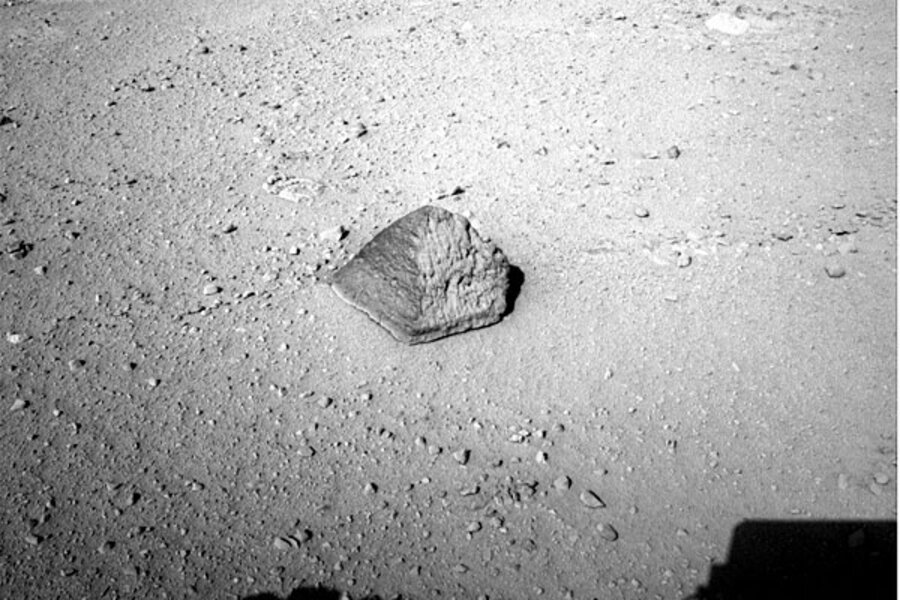Mini-Great Pyramid of Giza on Mars intrigues Curiosity rover team
Loading...
NASA's Mars rover Curiosity is eying a target for the first tandem test of two instruments crucial to the rover's mission of determining whether its new home, Gale Crater, as well as the crater's central Mt. Sharp, could have hosted life early in the planet's history.
At 16 inches wide and about 10 inches tall, the target rock looks like a miniature Great Pyramid of Giza, with one face artisans neglected to maintain.
But it's just the ticket for testing the rover's ChemCam and and Alpha Particle X-Ray Spectrometer (APXS), a complementary set of tools for determining the composition of the rocks and soils the rover will encounter during its two-year prime mission on Mars.
Six weeks into its visit to the Red Planet, Curiosity is performing well, noted Richard Cook, deputy project manager for the Mars Science Laboratory mission. It has traveled 289 meters (948 feet) from its touchdown spot at Bradbury Landing on the floor of Gale Crater.
That means the research team is more than half way to its first major science destination, Glenelg, an area marked by the confluence of three distinct types of terrain. These include formations that appear to consist of the same type of heat-capturing rock seen elsewhere on the crater floor from orbit, says John Grotzinger, a planetary scientist at the California Institute of Technology in Pasadena, Calif., and the mission's project scientist.
That rock is of interest because its ability to retain heat is similar to that of rocks on Earth that have been cemented through interaction with water. Finding geochemical evidence that the crater once could have hosted water that persisted long enough to help form such rocks could help strengthen the case that this patch of the planet might once have been suitable for sustaining microbial life.
During the commute to Glenelg, scientists have been looking for a rock that looks to have uniform composition to run joint experiments with ChemCam and the APXS, Dr. Grotzinger said during a briefing on Wednesday.
The rock the team has settled on looks to meet that requirement; it looks to be made of basalt – of volcanic origin. It's a rock type with which the researchers are very familiar and, indeed, Curiosity carries a small piece of basalt as a calibration target for ensuring the APXS is working properly.
But that's not its only draw. "It's just a cool-looking rock there," Grotzinger adds.
The stone also carries some sentimental value. The Curiosity team has named it for Jake Matijevic, an engineer at NASA's Jet Propulsion Laboratory in Pasadena who passed away shortly after Curiosity landed. Mr. Matijevic played a vital role in each of the rover missions NASA has sent to Mars, including the current one.
The ChemCam/APXS test will mark the first attempt at "contact" measurements, in which Curiosity's arm will bring the instrument turret constituting its "hand" close to a rock. The X-ray spectrometer is one of the instruments on the turret.
During the past week, Curiosity also has played the role of astronomer, building movies of the partial transit of the sun by Phobos, one of Mars's two diminutive moons. Both Phobos and Deimos exert tiny but measurable tidal forces on the Martian crust, which changes the planet's shape, in turn altering the moons' orbits, notes Mark Lemmon, a researcher at Texas A&M University and a co-investigator on MastCam, a high-resolution camera atop Curiosity's seven-foot mast.
Monitoring the transits allows researchers to determine the orbits of the moons with high precision. From that, scientists can determine how fast the orbits are changing. For Phobos, which is slowly spiraling in toward the planet, that's a big deal. Dr. Lemmon notes that Phobos's ultimate fate is to break up and pepper the planet with its remains.
For researchers interested in Mars's innards, information on the moons' orbits and their effect on the shape of Mars also yield insights into the planet's interior structure, he says. Transits and partial transits happen often enough on Mars to make these observations a MastCam staple.





